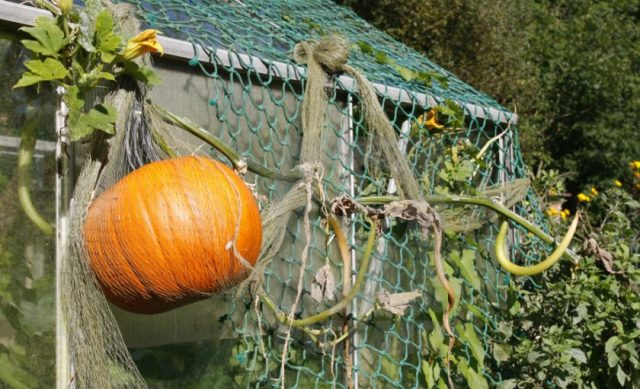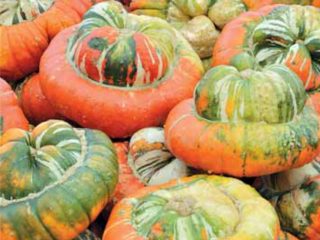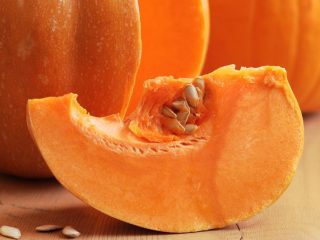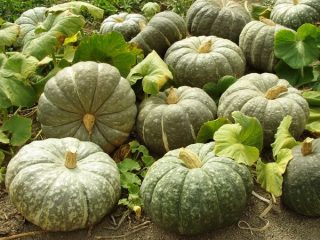Content
Russian pumpkin is a large fruit with a rich aroma, sweet flesh and bright color. The variety is included in the VNIISSOK selection. The vegetable crop has high frost resistance and is therefore suitable for cultivation in the Central regions, including the Moscow region.
There are huge specimens of the Rossianka variety, weighing up to 60 kg. In addition, this pumpkin has a rich mineral composition: fats, proteins, carbohydrates, calcium salts, potassium, magnesium and iron. Microelements – cobalt, copper, zinc. Vitamins – groups B, C, PP, carotenoids.
Description of Russian pumpkin
The Russian pumpkin variety is a medium-climbing, early-ripening, hardy plant. The bush has compact dimensions. Scourges grow up to 3 m in length. The root system is powerful. The foliage is wide, green, five-lobed.
The full cycle from planting to ripening is 90-110 days. It is preferable to grow Russian pumpkin in open ground. For the variety to fully develop, a small area is enough; vertical supports can be used. The flowers are single, large, yellow in color.
Description of fruits
The Russian pumpkin variety is distinguished by its large fruit. The average weight of the fetus is from 2 to 4 kg. The shape is turban-shaped. The surface is smooth. The color of the pumpkin is red-orange.
The taste is harmonious. The flesh is bright orange. The peel is dense, the wall thickness is 6 cm. It contains a large amount of zinc, so it must be removed before cooking. The structure of the inside of the Russian pumpkin variety is crumbly and soft. The taste is sweet. A distinctive feature of the variety is its melon aroma.
Characteristics of the variety
Vegetable crops are not demanding on the chemical composition of the soil. However, it does not grow well in depleted soils. Pumpkin is a heat-loving plant. Young bushes cannot tolerate temperatures dropping even to -1 °C. Grows in sunny beds. The Russian woman is enduring drought.
The vegetable is perfectly transportable, and thanks to the possibility of long-term storage, the pumpkin can be consumed until the next season. Culture has a universal purpose. Candied fruits, purees, and jams are made from pumpkin. The fruits are also boiled, fried and baked.
Resistance to diseases and pests
The Russian pumpkin variety suffers from fungal diseases. The bushes become covered with white spots, black mold, and the leaves and ovaries dry out. As a result, growth and development stops. Common diseases of the Pumpkin family: powdery mildew, anthracnose, white rot, root rot, bacteriosis.The main treatment is timely treatment of plants with systemic fungicides and removal of damaged areas. Sick bushes should be destroyed to prevent the development of the disease.
Young vegetable crops are weakened by melon aphids. These insects multiply quickly and form entire colonies. The first sign of aphids is curled leaves. Small parasites suck out the juice and spoil the inflorescences and formed ovaries. You can fight aphids with folk remedies: wormwood infusion, soap solution, onion peel decoction. Among the chemical preparations aimed at combating melon aphids on the large-fruited Russian pumpkin, reviews note: “Trifos”, “Karbofos”, “Aktellik”.
Preventive measures will help prevent the spread of infection and prevent fungal diseases:
- deletion weed, regular weeding of the area;
- use of proven, high-quality seeds;
- lack of frequent watering;
- moderate feeding of plants with nitrogen fertilizers;
- compliance with crop rotation rules.
Advantages and disadvantages
Russian pumpkin is popular among gardeners. It combines a number of positive qualities. Advantages:
- productivity;
- early ripeness;
- same size pumpkins;
- disease resistance;
- transportability;
- keeping quality;
- the presence of a high sugar content in the pulp.
The disadvantages of the Russian pumpkin variety include the poor quality of planting material. Self-collected seeds are not suitable for planting, since the crop is of hybrid origin. And seeds sold in gardening stores are often found empty inside or spoiled.
Growing and caring for Russian pumpkin
Pumpkins of the Russian variety can be planted in the ground both in the form of seedlings and seeds. For the seedling method, you will need cups with a diameter of 10-15 cm and a specially prepared soil mixture. 2-3 hours before sowing, vegetable seeds are soaked in a growth stimulant solution.
After the sowing procedure, the containers are covered with film and put in a warm place until the first shoots appear. Grown seedlings are hardened off daily. First take it outside for 20 minutes. Then the length of stay is gradually increased.
The Russian pumpkin variety is planted in the beds when the ground temperature is + 12 °C. It is recommended to plant plants in late May or early June. During this period, the threat of night frosts has passed.
A secluded garden bed protected from cold winds is considered a good place for growing vegetables. The greatest harvest will be obtained in moist, loose, fertile soils. In terms of mechanical composition, loam or sandy loam is optimal. The standard planting pattern is 100x100 cm. The depth of immersion of Rossianka seeds is 3-5 cm.
Be sure to prepare the area before planting a vegetable crop.
- Dig up the soil to the depth of a bayonet with a shovel.
- Remove the rhizomes of weeds.
- Nitrogen fertilizers are distributed evenly. The norm is 20 g per 1 sq. m area.
- Level the bed with a rake.
- It is advisable to place pumpkins next to legumes and corn. Unfavorable neighbors will be: watermelons, melons, squash, zucchini.
The Russian pumpkin variety loves warmth. The temperature comfortable for full growth is + 22-27 °C. With a slight cooling, the plant begins to die. To prevent this from happening, covering material is used in cold regions. It will help retain moisture and heat in the soil.
The vegetable crop withstands periods of drought. The branched root system is capable of going deep into the ground to a depth of 3 m. It is enough to water the Russian pumpkin once every 7 days. The volume of water for one plant is 3-4 liters.
In the process of growing vegetables, do not forget about timely weeding and loosening. To make the bush lush, pinch the top. And when the size of the stem reaches 150 cm, lateral shoots will appear.
Fertilizers must be applied. Humus is used from organic substances. Among the mineral supplements you can choose: superphosphate, potassium salt, ammonium nitrate.
In the photo there is a pumpkin of the Russian variety, which is 4 months old. As a rule, the harvest of ripe vegetables begins in late summer or early September. It is important to do this before the first frost, frozen fruits have a short shelf life.
A ripe Russian pumpkin has:
- hard, strong skin;
- yellowed leaves;
- woody stalk;
- deep orange color.
This fruit can be stored for up to 6 months. The main thing is to put the vegetable in a dry, well-ventilated room with a temperature of + 14 °C. However, you should not save it until spring, since irreversible processes begin to occur inside. The seeds germinate and the pulp becomes bitter. The process of natural movement of juices starts. In this state, harmful substances accumulate in the Russian pumpkin, which can cause poisoning.
Conclusion
Russian pumpkin is an unpretentious plant. Even a person without experience can grow it. Agrotechnical measures require standard ones.Suitable for cultivation in the Central regions. The taste of the vegetable crop is excellent. The variety combines visual attractiveness, high fruiting and the ability for long-term storage.












